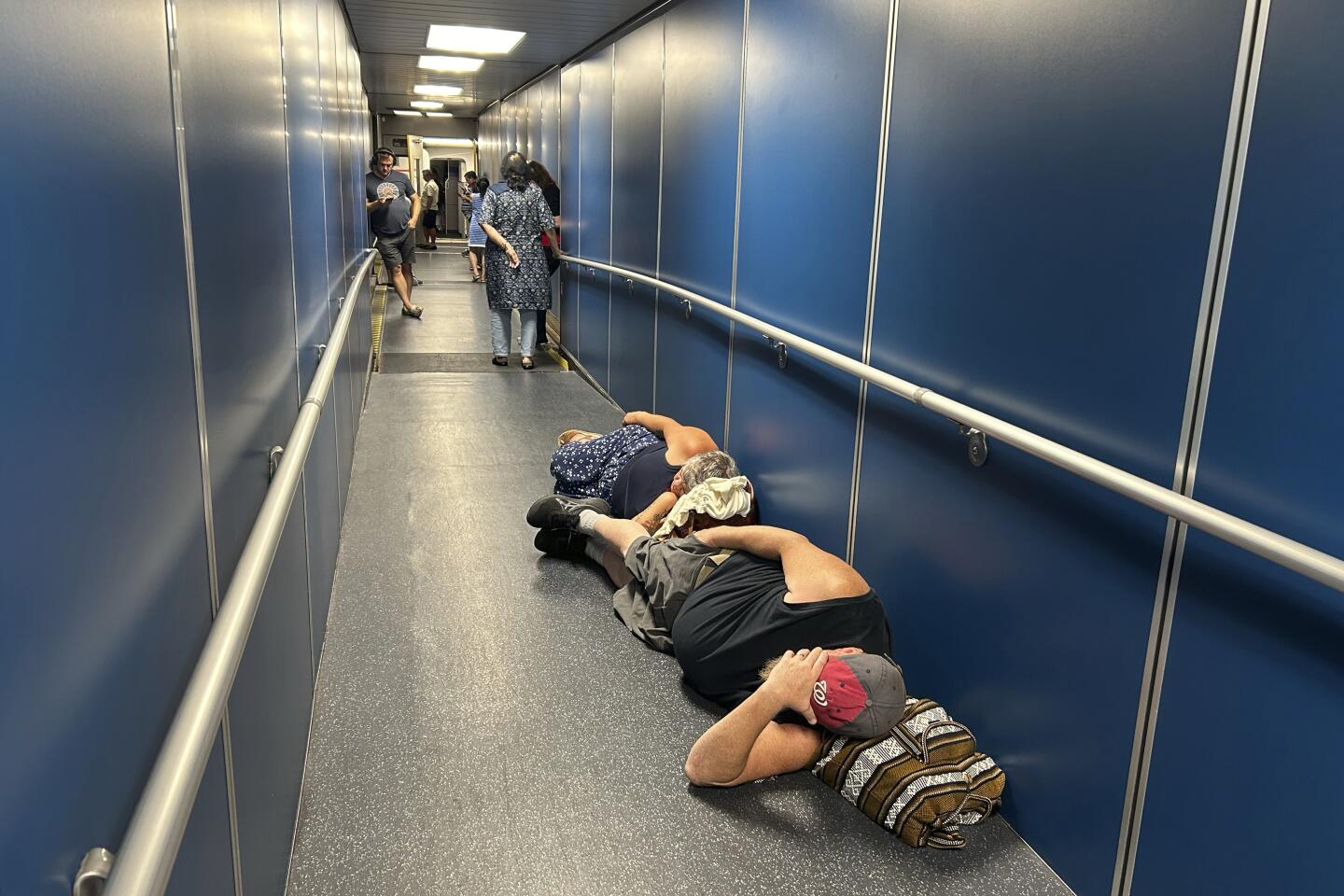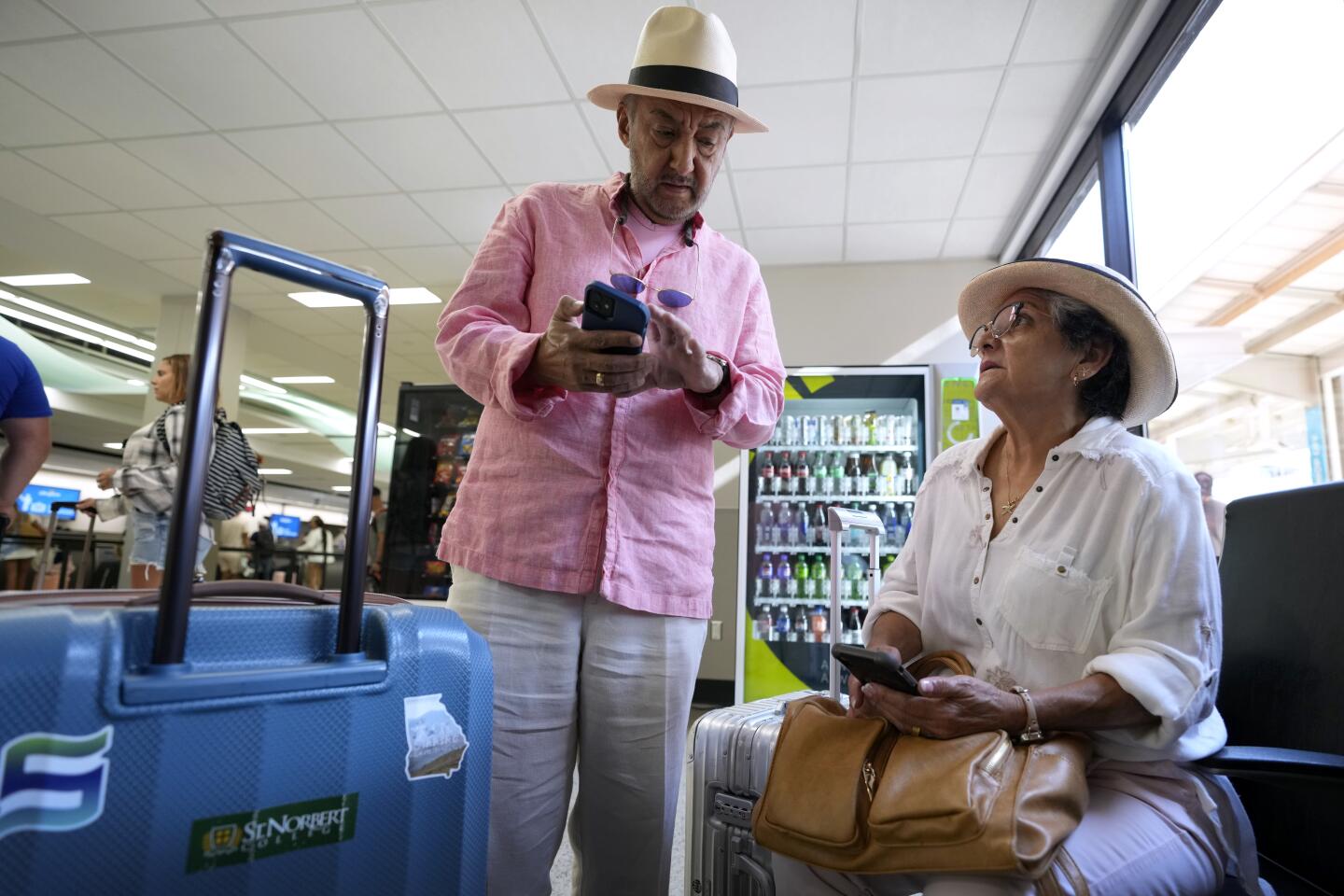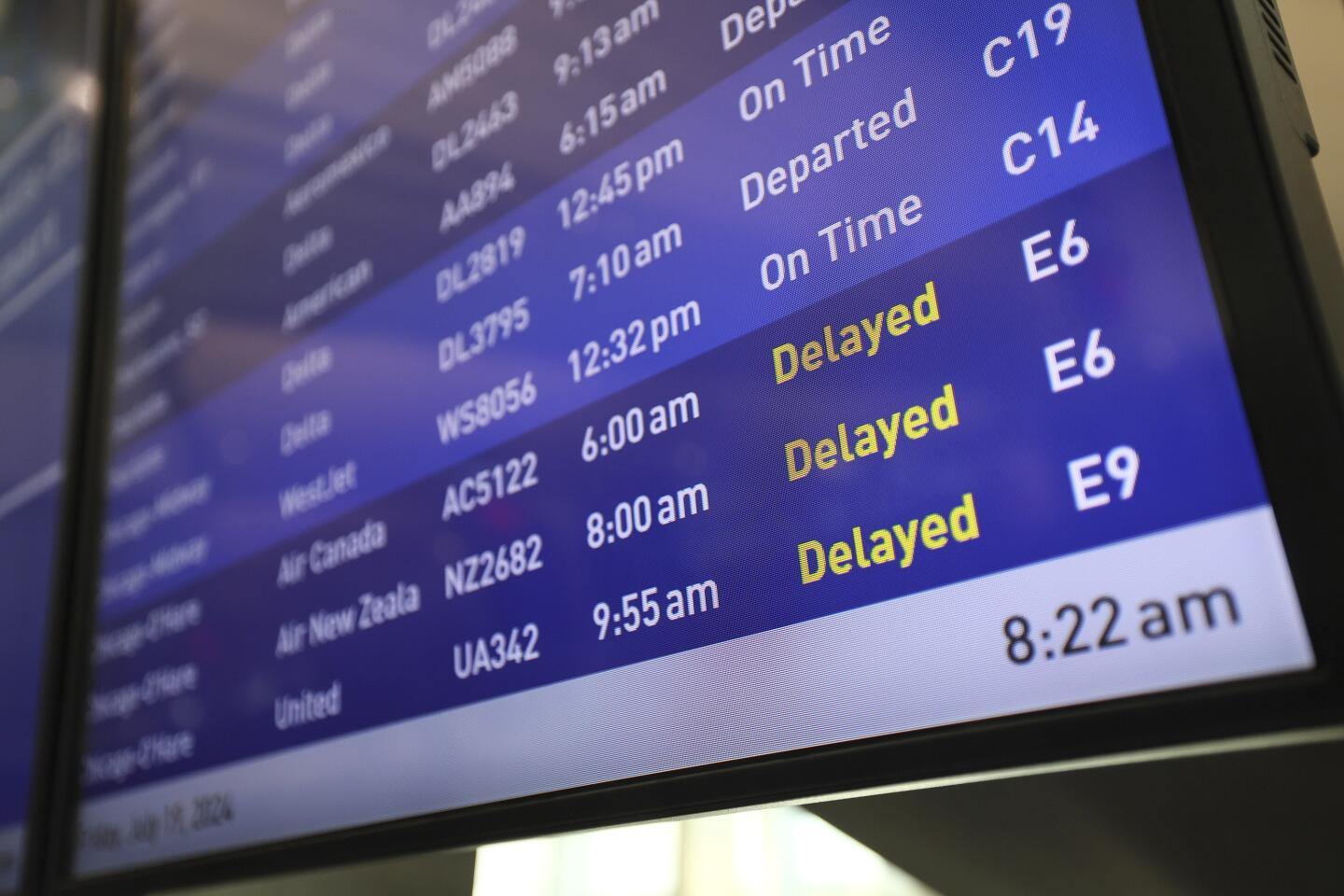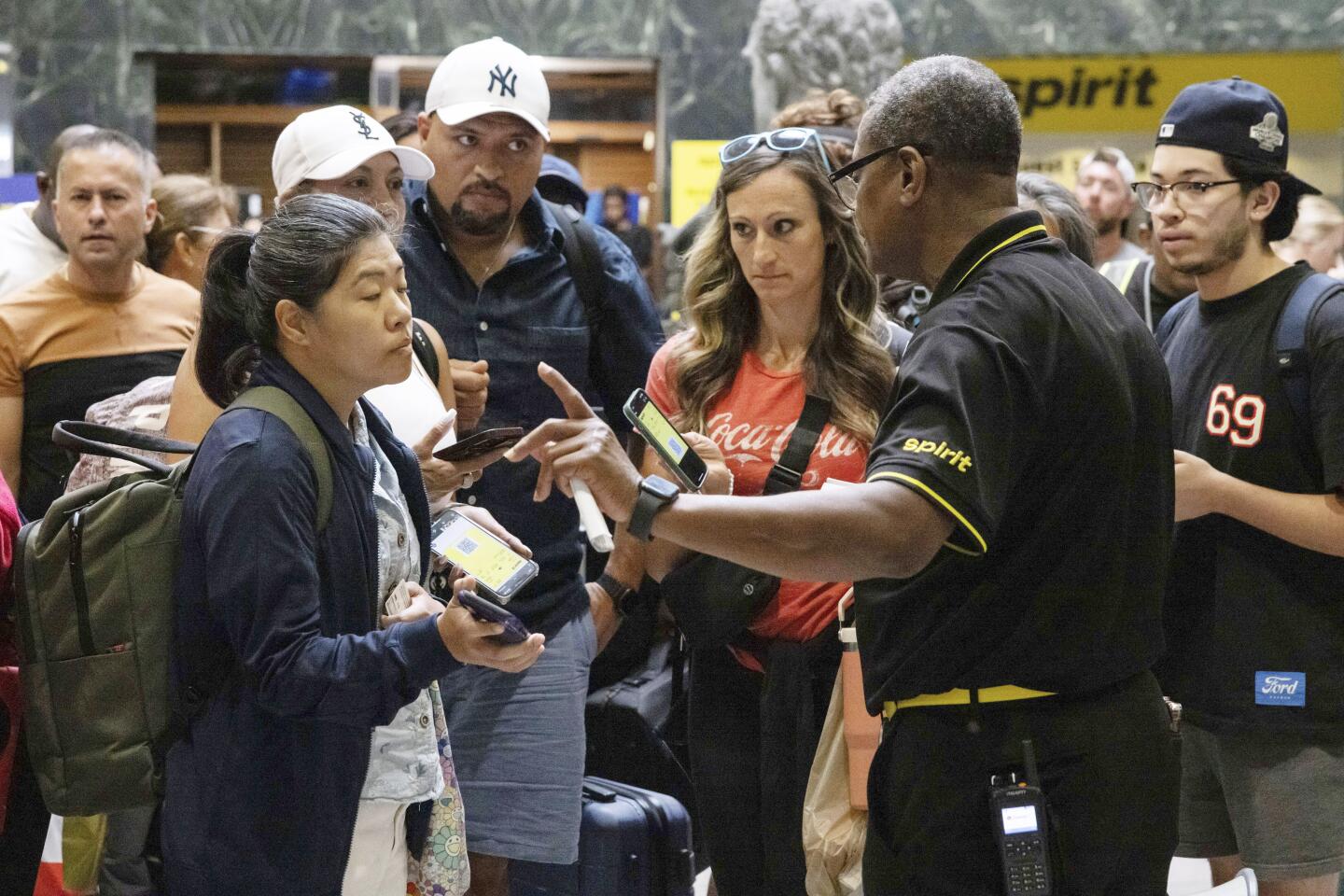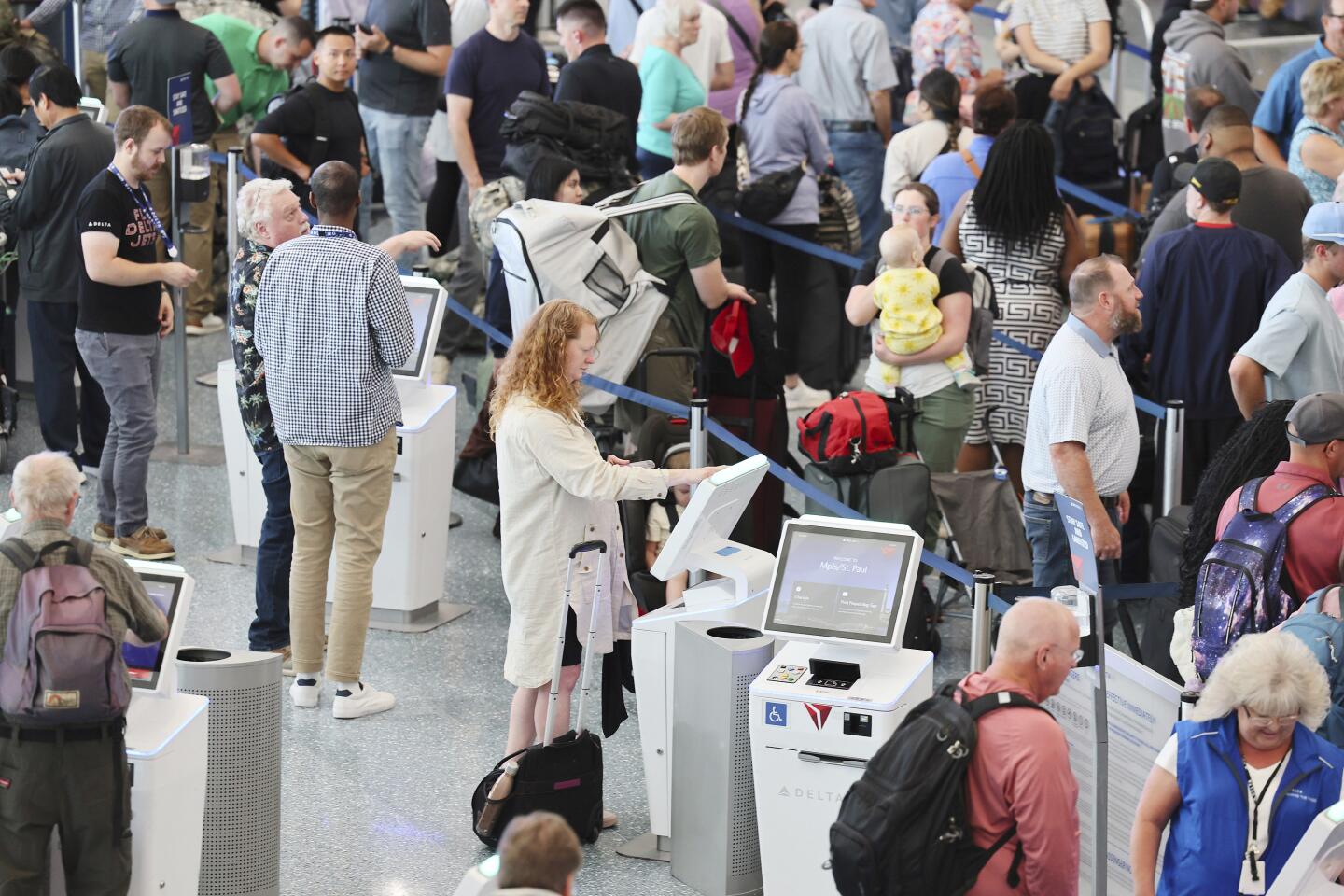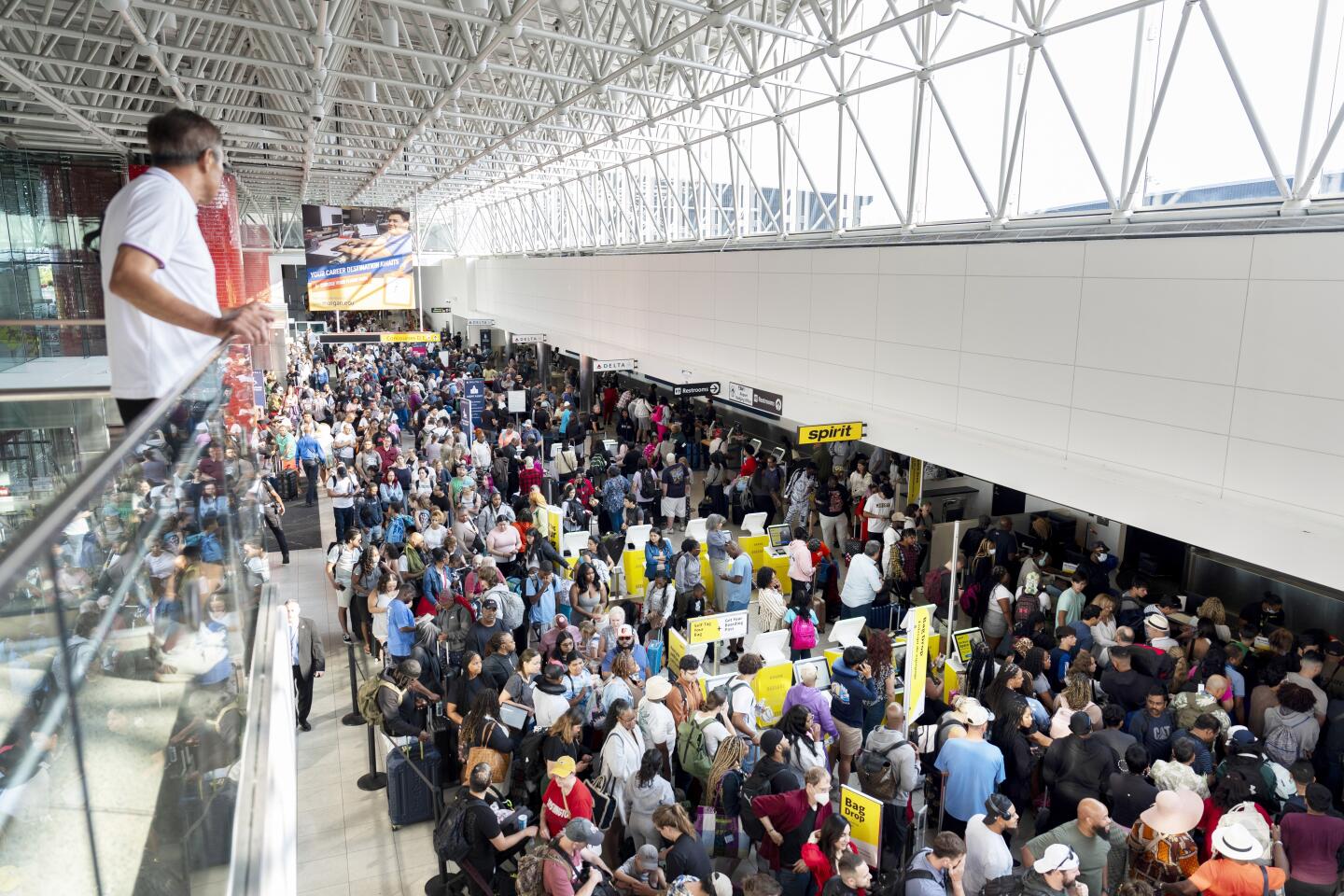From LAX to hospitals to Starbucks, global tech outage brings chaos and frustration
- Share via
Airlines, banks, healthcare systems, government agencies and other industries across California scrambled to recover Friday from the effects of a widespread global technology outage.
Roughly 100 flights had been canceled by midmorning Friday at Los Angeles International Airport, and even more were delayed. Overnight, travelers facing long delays and cancellations were resigned to trying to get some sleep on the airport’s well-trodden carpeted floor. Some used their luggage as pillows.
At some California hospitals, staff said the outage prevented them from accessing patient charts.
Starbucks faced major disruption to its mobile ordering service throughout the day Friday, meaning caffeine seekers had to place their orders in person at stores, resulting in longer-than-typical lines. Some locations closed for the day.
Some government agencies reduced services.
Travelers at other California airports were facing issues similar to LAX’s.
The chaos stemmed from a faulty update sent by CrowdStrike, a Texas cybersecurity company whose software is widely used, that interfered with the core functions of computers running Microsoft Windows. This caused Microsoft’s infamous “blue screen of death” to pop up and convey a message along the lines of, “Your PC ran into a problem and needs to restart.” The outage was not a security incident or a cyberattack, CrowdStrike said.
The company’s chief executive, George Kurtz, said Friday morning that a fix had been made.
“We understand the gravity of the situation and are deeply sorry for the inconvenience and disruption. We are working with all impacted customers to ensure that systems are back up and they can deliver the services their customers are counting on,” Kurtz wrote on X.
Meanwhile, the defect rippled across technology worldwide. There were reports that some airports were beginning to restart service, but it was unclear when operations would return to normal.
The California Governor’s Office of Emergency Services wrote on X that officials are “closely monitoring the global software outage.”
“Initial reports indicate minor state system outages,” the office wrote. “However, all 911, public safety communications and critical infrastructure is functioning as expected.”
LAX first started to see glitches late Thursday. The outages were initially limited to Frontier Airlines and a few other carriers and were caused partially by a software issue with Navitaire, a boarding pass printing system. The issue grew as more and more airlines began to face the same problems. Delta, American and United airlines were also affected.
A representative for LAX emphasized that the issues facing the airport did not affect flight safety. When a patch of code that caused the problem was fixed in CrowdStrike, the airport started to see airlines come back online, but it is still facing many more delays and cancellations than usual.
On Friday, LAX had more than 70 cancellations before 7 a.m., compared with 14 all day on Wednesday. An hour later that number had swelled to 100 cancellations and 188 delays. At San Francisco International Airport, the numbers were similar. There were 16 cancellations on Wednesday compared with more than 70 Friday morning.
More than 8,800 flights were delayed and more than 2,600 had been canceled across the United States, according to data provided by FlightAware.
Los Angeles Mayor Karen Bass was in touch with leadership at Los Angeles World Airports who were “working actively to resolve travel issues,” said Zach Seidl, a spokesperson for the mayor.
“Travelers at LAX and other regional airports should plan ahead for potential delays,” he said.
Frustration among airline employees and passengers was widespread at the airport. Some tried to sleep on a luggage conveyor belt before an airport employee shouted for them to get up.
“It was terrible. It is terrible,” said Elissa Moore, 29. “Cause we’re still going through it.”
Shortly before 6 a.m., a Delta representative took to the intercom to tell passengers that the airport was still allowing planes to land, but that for the time being, all outbound flights were grounded. He advised travelers who are from L.A. to “go home” and check for updates on the company’s app or website.
He added that the company’s system was completely shut down and that the resulting crippling of flight operations was “worse than 9/11.”
Passengers reported waits of up to two hours to get through security into Terminal 2, as many people whose flights were canceled were instructed to retrieve their baggage before trying to rebook their flight.
Passengers whose flights had been canceled stood sullenly in line to rebook but could not complete that task either because of the outages. One video showed a woman at LAX hugging a Delta employee as she cried.
Outside were dozens of planes on the tarmac with nowhere to go.
Gabrielle Watson, an L.A. DJ and music producer, arrived at LAX on Thursday night to catch her 11:59 p.m. United Airlines flight to Chicago with a connection to Columbus, Ohio, so she could play a set Friday at the Secret Dreams Festival.
Watson knew there were problems immediately when she got to her gate and saw the blue screens displayed. Still, her flight boarded and she remained on the plane for hours as delays ravaged the airport.
After about three hours, passengers deplaned and Watson went home, realizing she was not going to make her connecting flight in Chicago. Her flight was canceled about five hours after its scheduled departure time.
“There were a lot of upset people,” she said. “They were spread around on floors everywhere trying to be comfortable waiting for information. It was very stressful and a bit dark.”
Some observers have argued the incident demonstrates the risk of having one potential point of failure affecting millions of computers. At the very least the disruption shows the need for better software in crucial systems, some experts say.
U.S. Transportation Secretary Pete Buttigieg said that although new technology has brought major benefits to efficiency and safety, they also have specific vulnerabilities that must be addressed.
“These are the kinds of disruptions that nobody wants to experience, and we’ll be pressing airlines and the software community on what they’re doing to get ahead of this for the next time,” he said.
The effects of the outage went beyond aviation.
Within the Providence healthcare system, IT teams worked overnight to restore functionality in electronic health records. The healthcare company noted that other clinical applications and workstations were still not up and running as of Friday afternoon.
Cedars-Sinai Medical Center said it was also experiencing fallout from the software outage, though the hospital remained open Friday.
“We are actively working to address the issue and minimize any impacts,” the hospital said in a statement. “We thank our patients and our staff for their flexibility during this unexpected event.”
The outage even upended people’s coffee fix.
“We continue to welcome and serve customers in the vast majority of our stores and drive-thrus and are doing everything we can to bring all systems online as quickly as possible. We apologize for any inconvenience,” said Jaci Anderson, a spokesperson for Starbucks.
The California Department of Motor Vehicles was forced to scale back services at offices statewide. Online services and kiosks were not affected by the outage, according to the agency.
People in California’s jails were unable to make or receive phone calls because of the outage. The software update affected ViaPath, the communication technology used in jails, according to the California Department of Corrections and Rehabilitation. It is not clear when the system will be up and running.
“CDCR understands how important it is for incarcerated people to stay connected with their loved ones and is diligently working to resolve this matter,” a spokesperson told The Times.
The Los Angeles County Superior Court system was forced to postpone cases in which litigants were scheduled to appear remotely Friday. The court said in a statement it is “rapidly working to reestablish connectivity.”
A terminal at the Port of Los Angeles and four terminals at the Port of Long Beach were also temporarily affected by the outage overnight. But the ports were operating normally Friday, officials said.
KGO-TV, the ABC affiliate in San Francisco, couldn’t go on air as scheduled for its 11 p.m. newscast. Instead anchors delivered the day’s top headlines via Facebook live.
Times staff writers Joseph Serna, Ruben Vives, Libor Jany, David Zahniser, Jon Healey and Sandra McDonald and the Associated Press contributed to this report.
More to Read
Sign up for Essential California
The most important California stories and recommendations in your inbox every morning.
You may occasionally receive promotional content from the Los Angeles Times.
